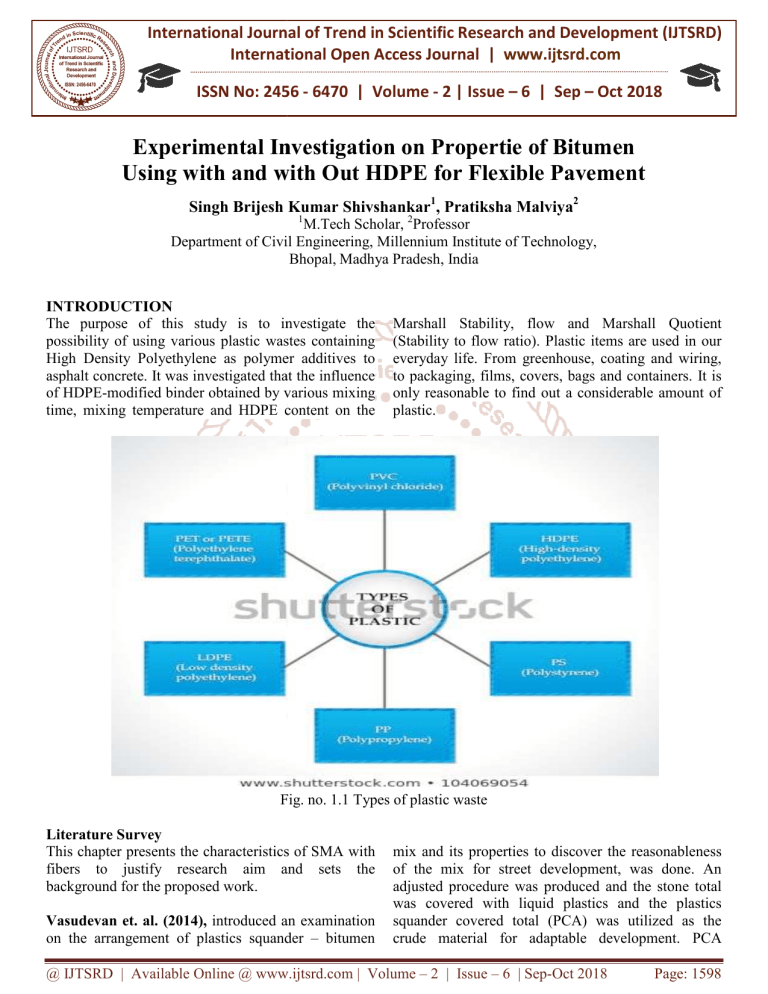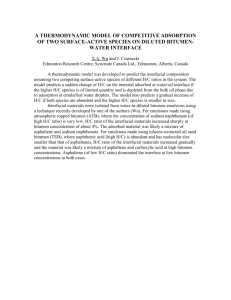
International Journal of Trend in Scientific Research and Development (IJTSRD)
International Open Access Journal | www.ijtsrd.com
ISSN No: 2456 - 6470 | Volume - 2 | Issue – 6 | Sep – Oct 2018
Experimental Investigation on Prop
Propertie
ertie of Bitumen
Using with and with Out HDPE for
or Flexible Pavement
Singh Brijesh
ijesh Kumar Shivshankar1, Pratiksha Malviya2
1
M.Tech Scholar, 2Professor
Department
rtment of Civil Engineering, Millennium Institute off Technology,
Technology
Bhopal, Madhya Pradesh, India
INTRODUCTION
The purpose of this study is to investigate the
possibility of using various plastic wastes containing
High Density Polyethylene as polymer additives to
asphalt concrete. It was investigated that the influence
of HDPE-modified
modified binder obtained by various mi
mixing
time, mixing temperature and HDPE content on the
Marshall Stability, flow and Marshall Quotient
(Stability to flow ratio). Plastic items are used in our
everyday life. From greenhouse, coating and wiring,
to packaging, films, covers, bags and containers.
conta
It is
only reasonable to find out a considerable amount of
plastic.
Fig. no. 1.1 Types of plastic waste
Literature Survey
This chapter presents the characteristics of SMA with
fibers to justify research aim and sets the
background for the proposed work.
Vasudevan et. al. (2014), introduced an examination
on the arrangement of plastics squander – bitumen
mix and its properties to discover the reasonableness
of the mix for street development, was done. An
adjusted procedure was produced and
a the stone total
was covered with liquid plastics and the plastics
squander covered total (PCA) was utilized as the
crude material for adaptable development. PCA
@ IJTSRD | Available Online @ www.ijtsrd.com | Volume – 2 | Issue – 6 | Sep-Oct
Oct 2018
Page: 1598
International Journal of Trend in Scientific Research and Development (IJTSRD) ISSN: 2456-6470
2456
demonstrated better restricting property. It had less
wetting property. Its voids were subst
substantially less.
The example demonstrated higher Marshall Solidness
esteem. The streets laid utilizing PCA are performing
admirably. A point by point contemplated is
displayed.
Vasudevan et. al. (2015), additionally watched that
the polymer mixed bitumen has
as better properties with
respect to Softening point, Entrance point, Flexibility,
Stripping Worth and Marshall Dependability esteem.
Subsequently the mix can be utilized for laying
adaptable asphalt. In this examination both dry and
wet procedures were utilized
ilized to get ready changed
bituminous blends. In the wet procedure, the mixing
was done by straightforwardly blending the destroyed
polymer with hot bitumen at 160 deg. C. In the dry
procedure, a novel system was utilized to utilize
higher level of waste plastics in street development
and utilizing this strategy a substitute technique was
utilized. In this strategy, the waste polymer was
included the hot total (170deg.C). The polymer was
covered over the total. Here the spreading was simple.
The hot total was covered with polymer consistently.
At that point the Bitumen was included. The blending
of bitumen with polymer was occurring at the surface
of the total. The temperature was around 155 – 163 C.
Both the polymer and bitumen were in the fluid state.
Objectives
To study the physical properties of 60/70 grade
bitumen.
To study properties bitumen with HDPE and
without HDPE.
1. Results with Ordinary Bitumen
5.3.1.1 Physical Properties of Aggregate:
Laboratory test has been performed to find the
physical properties of aggregate for dense bituminous
mix and the results obtained are given below in table
(5.3)
Table 5.3: Physical Properties of Aggregate
Aggregate
Property
20 mm 10 mm 6 mm Dust Cement
Specific Gravity 2.72
2.67
2.63 2.61
3.07
Density (g/cm³)
1.54
1.48
1.47 1.42
1.32
5.3.1.2
Physical properties of 60/70 grade
bitumen:
Different test were performed to find the physical
properties of ordinary bitumen and the results
obtained are given below in table (5.4)
Table 5.4: Physical properties of 60/70 grade
bitumen:
S.
Test
Properties
No.
Results
Penetration at
1
65
25°C/100gm/5Sec,mm
2
Softening point, °C
60
3
Ductility, cm
98
4
Specific gravity, at 27°C
1.001
5
Flash point, °C
318
6.
Fire point, °C
340
5.3.1.3
Physical Properties of 60/70 grade
Modified Bitumen:
Different properties of modified bitumen with the
addition of HDPE percentages (0%, 2%, 4%, and 6%)
were found in laboratory. The results obtained are
given in the table 5.5.
5.3.1.4
Resultss of Marshal Mix Design for DBM
with ordinary bitumen (60/70 grade):
Samples of ordinary bitumen were prepared with
varying percentage of bitumen (4.5% to 6.0%) and
marshal stability test were conducted on each sample.
The physical properties
perties of each sample are measured
and calculated. The graphs have been plotted to find
the optimum binder content which comes out to be
5.5% of bitumen. The results obtained are shown in
Table 5.6.
Following graphs have been plotted to find the
optimum binder content:
Binder content vs Marshal stability (fig. 5.1)
Binder content vs flow value (fig. 5.2)
Binder content vs Bulk Density (fig. 5.3)
Binder content vs Air voids (fig. 5.5)
Binder content vs Voids filled with mineral (fig.
5.5)
Binder content vs Voids filled with bitumen (fig.
5.6)
@ IJTSRD | Available Online @ www.ijtsrd.com | Volume – 2 | Issue – 6 | Sep-Oct
Oct 2018
Page: 1599
International Journal of Trend in Scientific Research and Development (IJTSRD) ISSN: 2456-6470
2456
Figure 5.1: Bitumen % Vs Marshal Stability Value
Figure 5.5: Bitumen % Vs Voids filled with
bitumen %( VMA)
Figure 5.2: Bitumen % Vs Flow value
Figure 5.6: Bitumen % Vs Voids filled with
bitumen %( VFB)
Figure 5.3: Bitumen % Vs Bulk Density
5.3.2 Results of DBM with HDPE:
The results and analysis for ordinary bitumen mix
shows that optimum binder content for the mix is
5.5% of the total weight of the aggregate.
a
By using
this optimum binder content i.e. 5.5% various samples
of varying HDPE percentages (2%, 4% and 6%) were
prepared and subsequent test have been performed to
find properties of modified dense bitumen mix. The
table (5.5) shows various properties
prope
of HDPE
modified DBM.
The results show that increase in percentage of HDPE
in mix increases marshal stability value, bulk density
and voids filled with bitumen (VFB) but decreases air
voids.
Figure 5.4: Bitumen % Vs Air voids %
It has been observed that modified mix shows better
properties at 4% HDPE. Now the test were performed
to find the optimum binder content with 4% HDPE
modified mix. The results obtained are given below in
table (5.6).
Table 5.5: Properties of DBM with HDPE Modified bi
bitumen when using
ing optimum binder content (5%)
Weight of
Marshal
Bulk
Air
sample
HDPE
Flow value
VMA VFB
S.No
stability
Density
Voids
(gm)
%
(mm)
%
%
(Kg)
(gm/cc)
%
Air
Water
1
2%
1195
690
1297
2.45
2.367
3.97
13.38 70.34
2
4%
1188
688
1345
2.57
2.376
3.85
14.60 73.63
3
6%
1186
687
1445
2.63
2.378
3.79
15.26 75.17
@ IJTSRD | Available Online @ www.ijtsrd.com | Volume – 2 | Issue – 6 | Sep-Oct
Oct 2018
Page: 1600
International Journal of Trend in Scientific Research and Development (IJTSRD) ISSN: 2456-6470
2456
Table 5.6: Properties of DBM with 6% HDPE modified bitumen and varying percentage of bitumen
binder
Weight of sample
Marshal
Bulk
Air
Bitumen
Flow value
VMA VFB
(gm)
S.No
stability
Density
Voids
%
(mm)
%
%
(Kg)
(gm/cc)
%
Air
Water
1
4
1193
692
1350
2.58
2.38
4.58
14.48 68.39
2
4.5
1189
690
1390
2.63
2.39
4.46
14.97 70.15
3
5
1188
693
1445
2.78
2.40
4.23
15.32 72.37
4
5.5
1195
694
1410
2.86
2.385
4.04
15.46 75.84
Following graphs have been plotted to find the
optimum binder content
1. Binder content vs Marshal stability (fig. 5.7)
2. Binder content vs flow value (fig. 5.8)
3. Binder content vs Bulk Density (fig. 5.9)
4. Binder content vs Air voids (fig. 5.10)
5. Binder content vs Voids filled with bitumen (fig.
5.11)
6. Binder content vs Voids filled with bitumen (fig.
5.12)
Figure5.9: Bitumen % Vs Bulk Density
It is observed from graphs, that maximum marshal
value is obtained with 5% modified bitumen
compared 5.5% ordinary bitumenn in DBM.
It is therefore inferred that 6% HDPE admixture saves
bitumen content, without adversely affecting Marshal
Stability Value.
Figure 5.10: Bitumen % Vs Air voids %
Figure 5.7: Bitumen % Vs Marshal Stability Value
Figure 5.11: Bitumen % Vs VMA %
Figure 5.8: Bitumen % Vs Flow value
Figure 5.12: Bitumen % Vs Voids filled with
bitumen % (VFB)
@ IJTSRD | Available Online @ www.ijtsrd.com | Volume – 2 | Issue – 6 | Sep-Oct
Oct 2018
Page: 1601
International Journal of Trend in Scientific Research and Development (IJTSRD) ISSN: 2456-6470
2456
CONCLUSION
Marshall’s mix design conducted on DBM using
HDPE results as per MORTH recommendations,
indicate the acceptability of the HDPE in
Bituminous Concrete mix, since in acceptable
range.
REFERENCES
1. Aslam Shahan-ur-Rahman
Rahman “Use of Waste Plastic
in Construction of Flexible Pavement”, New
Building Materials & Construction World 2009.
2. Chandra, R. and Rutsgi, R. (1997).
“Biodegradation of Maleated Linear Low Density
Polyethylene and Starch Blends.” Polymer
Degradation and Stabilization. 56. 185
185-202
3. Food Science and Technology, 14, 71
71–78
4. Gopalakrishnan K. S. “An Insight into
Rubberized Roads, Indian Road Congress
Seminar on Bituminous Roads” Design and
Construction Aspects 1994. III
III. Effect of
Amylopectin to Amylase Ratio in Starch.
European Polymer Journal. 34(10): 1467
1467- 1475.
5. IRC: SP: 53 “Guidelines on the use of polymer
and rubber modified bitumen in rroad
construction.” Indian Road Congress, New Delhi
2002.
6. Justo C. E. G. , Veeraragavan A “Utilization of
Waste Plastic Bags in Bituminous Mix
for Improved Performance of Roads”, Centre for
Transportation
Engineering,
Bangalore
University, Bangalore, India, April 2002.
7. Khan Amjad, Gangadhar, Murali Mohan, Raykar
Vinay, "Effective Utilisation of Waste Plastics in
Asphalting of Roads". R.V. College of
Engineering, Bangalore 1999.
8. Khanna S. K., Justo C. E. G, A Text Book of
Highway Engineering, Nem Chand Publication
Publi
New Delhi 2001.
9. LEBBAI SHEIKNA, S. V. SIVA PRAKASH S. Road
Construction with Plastic Wastes National
Conference on Recent Trends in Engineering
Sciences 2011.
10. Mali, S., & Grossmann, M. V. E. (2003). Effects
of yam starch films on storability and quality of
fresh strawberries. Journal of Agricultural and
Food Chemistry, 7005–7011.
7011.
11. Mali, S., L. S. Sakanaka, F. Yamashita and M. V.
E. Grossman. 2005. “Water Sorption and
Mechanical Properties of Cassava Starch Films
and Their Relation to Plastisizing Effect.
E
Carbohydrate Polymer”. 60(3): 283-289.
283
@ IJTSRD | Available Online @ www.ijtsrd.com | Volume – 2 | Issue – 6 | Sep-Oct
Oct 2018
Page: 1602

